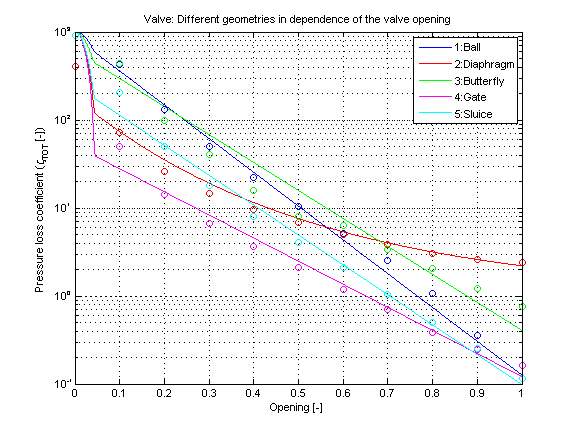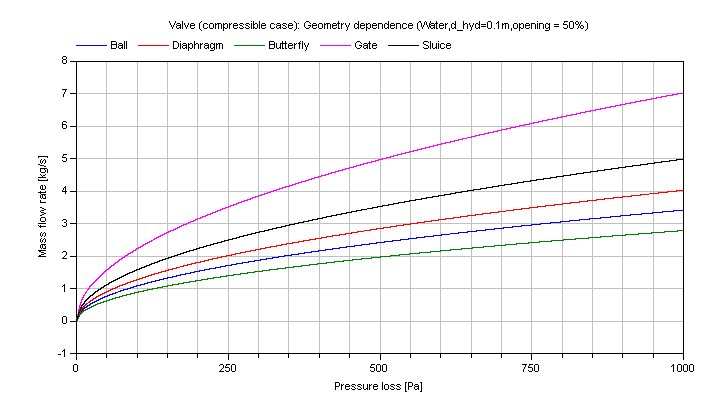 Modelica.Fluid.Dissipation.Utilities.SharedDocumentation.PressureLoss.Valve
Modelica.Fluid.Dissipation.Utilities.SharedDocumentation.PressureLoss.Valve Modelica.Fluid.Dissipation.Utilities.SharedDocumentation.PressureLoss.Valve
Modelica.Fluid.Dissipation.Utilities.SharedDocumentation.PressureLoss.Valve
Extends from Modelica.Icons.Information (Icon for general information packages).
| Name | Description |
|---|---|
 Modelica.Fluid.Dissipation.Utilities.SharedDocumentation.PressureLoss.Valve.dp_severalGeometryOverall
Modelica.Fluid.Dissipation.Utilities.SharedDocumentation.PressureLoss.Valve.dp_severalGeometryOverallCalculation of pressure loss for a valve with different geometries at overall flow regime for incompressible and single-phase fluid flow in dependence of its opening.
This function shall be used inside of the restricted limits according to the referenced literature.
Wide variations in valve geometry are possible and a manufacturer will not necessarily maintain geometric similarity between valves of the same type but of different size. Here pressure loss can be estimated for the following types of a valve:
The mass flow rate m_flow for valves out of pressure loss is determined by:
m_flow = [rho * dp * Av^2 / (zeta_TOT/2]^0.5
m_flow = (2/zeta_TOT)^0.5 * Av * (rho * dp)^0.5
m_flow = valveCharacteristic * Av * (rho * dp)^0.5
with
| rho | as density of fluid [kg/m3], |
| Av | as (metric) flow coefficient (cross sectional area) [m^2], |
| m_flow | as mass flow rate [kg/s], |
| valveCharacteristic | as coefficient of a valve in dependence of its opening [-], |
| velocity | as mean velocity [m/s], |
| zeta_TOT | as pressure loss coefficient [-]. |
The valveCharacteristic is determined out of a correlation for the pressure loss coefficient (zeta_TOT) in dependence of its opening. The reason for introducing an additional variable valveCharacteristic is a different definition of the following pressure loss correlations of valves.
The pressure loss coefficient (zeta_TOT) of a valve with different geometries are shown in dependence of the opening in the figure below.

Note that the pressure loss coefficients (zeta_TOT) are numerically optimized for very small openings (opening ≤ 5%). At openings smaller than 5% the pressure loss coefficient is smoothly set to a maximum value (zeta_TOT_max) to be adjusted as parameter. Therefore a very small leakage mass flow rate can be adjusted for a given pressure difference at almost closed valves. A very small leakage mass flow rate can often be neglected in system simulation with valves, whereas the numerical behaviour of the simulation is improved.
The mass flow rate of different valves at a constant opening of 50% in dependence of pressure loss is shown in the figure below.

Extends from Modelica.Icons.Information (Icon for general information packages).
Automatically generated Thu Dec 19 17:20:12 2019.